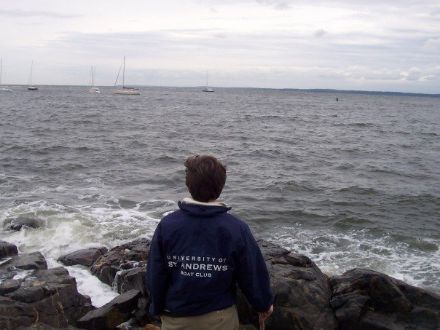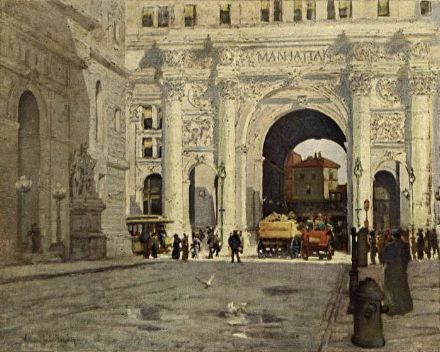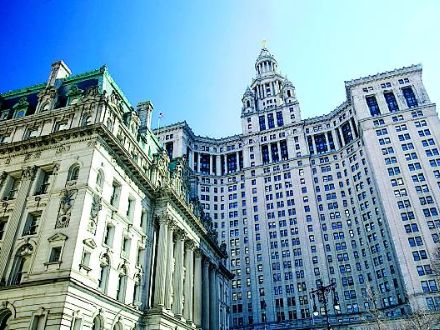New York
About Andrew Cusack
 Writer, web designer, etc.; born in New York; educated in Argentina, Scotland, and South Africa; now based in London.
Writer, web designer, etc.; born in New York; educated in Argentina, Scotland, and South Africa; now based in London. read more
News
Blogs
Reviews & Periodicals
Arts & Design
World
France
Mitteleuropa
Knickerbockers
Argentina
The Levant
Africa
Cape of Good Hope
Netherlands
Scandinavia
Québec
India
Muscovy
Germany
Academica
A Morning’s Journey
I crossed the Harlem River into Manhattan today just as Patrick Leigh Fermor traversed the Danube in his brilliant book, A Time of Gifts, which has immediately become one of my favorite reads of all time. Settling into my seat on the train yesterday, I opened my knapsack to utter shock and surprise—I had left my reading at home. The Leigh Fermor and P.G.W.’s Cocktail Time were resting somewhere in my bedchamber while I stared into the compartment of my bag, bare but for a photocopied page from the Art Newspaper and two (already-read) issues of the Hungarian Quarterly. These are the times that try men’s souls. Getting out of the city late in the evening proved even harder, as the bridge carrying the railway over the river was actually up for once (“First time in my life, folks,” the conductor informed us), leaving a steady backlog of trains awaiting their northerly destinations.
But this morning there were no bridge-raising complications, and the sky was a delightful, clear blue (soon to change) as we entered Manhattan. Thankfully, I had my two books; a bit of Wodehouse while waiting in Bronxville station and then Paddy Leigh Fermor on the train. After crossing the river, the train stops at 125th Street (Harlem) before submerging at 96th, taking the passenger down to Grand Central, that well-kept remnant on 42nd Street, reminding us that we too were once civilized. There, after taking a stroll through the market (Nürnburger sausage! Kaiser ham! Norwegian salmon!) you switch to the subway and hop down just one express stop on the 5 train.
Just half a dozen steps after emerging from Union Square station I saw a speck of white fall from the sky, and then another, and another. So it began: the first snowfall of the year. And, I might add, a New York record for the latest snowfall. (January 10th? No, there was no white Christmas for us this year). Two children on the swings in the playground ecstatically proclaimed their approval at the opening of the heavens. Wandering through the farmer’s market in the square, I picked up an herb focaccia bread I thought might be particularly enjoyable, and it complimented the exceptionally tasty Tuscan vegetable soup I had for lunch. The snowflakes swirled above the square and fell down on all the market-goers and the folks walking on Broadway as I marched up to work. And yet, how fleeting! In the few steps from the front door to the elevator, the white snow had already melted and merged into the green of my loden coat. Very well, Mother Nature. Very well.
Governors Island Revisited
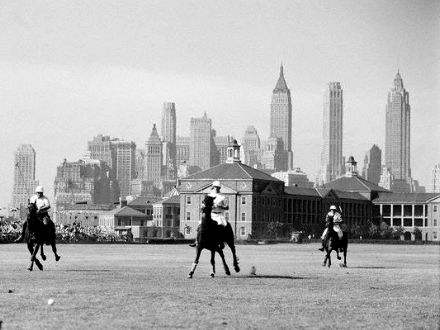
EVERY ONE OF THE myriad plans put forth for the ‘redevelopment’ of the venerable old Governors Island in New York Harbor has so far either stalled, been neglected, or otherwise poo-pooed. In this, we have something to rejoice. As I have often said, realistically speaking there is little that can be done to it which will not neglect or disgrace the island’s long military heritage. The officially-approved ideas put forth so far have been horrific: an amusement park, a casino, a ‘technology park’, as well as a number of other vapid proposals.
Naturally, we’d be enthused if it returned to its former role as swankiest post in the entire Army and the home of Army polo, but don’t hold your breath. West Point being the single exception, if it has even a touch of history, tradition, or class, Congress and the Department of Defense will do their best to get rid of it. After all, the National Guard has been pulled out of the Seventh Regiment Armory, the Navy has withdrawn all but a few institutions from Newport, and the Army has left the ancient Presidio of San Francisco; how long will it be until Fort Leavenworth’s foxhounds are brought out back and shot by the Monotony Monitors? (more…)
New York in November

Old Guard on Governors Island

A photo of the Old Guard of the City of New York on Governors Island, with Manhattan in the background, taken on St. George’s Day, 1933. [Click here for larger photo]
Previously: Evacuation Day | Marshal Foch and the Old Guard | A New York Funeral | Old Guardsmen | The Old Guard | Grandpa
Category: New York Militaria
An Evening at the Old Whitney
TO THE OLD Whitney Museum down on 8th Street, now home to the New York Studio School, which held a panel discussion to mark the twenty-fifth anniversary of the New Criterion. An interesting chat between Hilton Kramer, who left the New York Times to found the magazine in 1982, Karen Wilkin, one of our regular art critics, and James Panero, managing editor and art critic, all moderated by Michael J. Lewis of Williams College. The panel discussion covered myriad subjects related to art, from art criticism to the impossibility of an avant-garde in today’s culture of anything-goes to whether the New Criterion‘s ‘view’ of art can be considered part of any particular school of thought. Hilton had some particularly choice moments.
The building is a particularly nebulous one with many strange nooks and crannies, which can perhaps be explained by the fact that it is actually four townhouses gradually combined over a period of time. The Whitney Museum of American Art, of course, was founded in the 1930s by Gertrude Vanderbilt Whitney and was housed in these merged townhouses until moving to the specially-designed home at Madison and 75th in 1966 — widely agreed to be the ugliest building on the entire Upper East Side.
Among the nooks and crannies previously mentioned, Gertrude Vanderbilt Whitney’s former studio in the old mews building provided an excellent location for the dinner held afterwards, to which the participants, organizers, and a number of hangers-on (including yours truly) were invited. I sat between Gabbe, the New Criterion‘s former Editorial Assistant now working for the Studio School, and Joseph, an art student from outside Canterbury in Kent whose grandmother and grandfather both taught at the Studio School. Joseph and I discussed the beauty of the Somerset countryside, and I confessed I’d buy a cottage and move there in a second were it possible. The inimitable David Yezzi sat across the table and guided much of the conversation on our leg of the three tables, which had been arranged in a U-formation. A little later, I chatted with the artist seated to Gabbe’s left, who had been born in Latvia, with childhood spent in Baghdad, Italy, and England, before settling down in New York at the age of seven. We discussed the glories of Eastern Europe and the linguistic intricacies thereof. During dessert, however, I got on to architecture with the amiable Michael J. Lewis. I sung the praises of Audubon Terrace, one of my favorite spaces in all New York, which he (a Philadelphian) had only stumbled upon for the first time a month ago, and also of the nearby sculpted tomb of Bertram Grosvenor Goodhue, the greatest of all American architects.
Time waits for no man, however, and I managed to catch a late train back home from Grand Central. Alighting at Bronxville, I walked through the misty streets where the spherical streetlamps cast an eerie glow against the limestone façades of the shops. Home before midnight, and time for rest. Tommorrow, aside from being the feast of Saint Andrew, is Stefan Beck’s last day at the New Criterion. Needless to say, commemorative festivities are in order, and an alcoholic concoction known as ‘batch’ is to be brewed. It will not, I imagine, be for the faint of heart.
Elsewhere, the Austrian navy is no more.
Evacuation Day
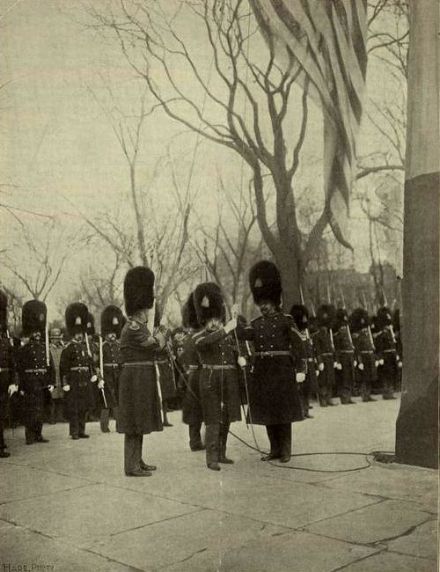
The Old Guard of the City of New York, raising the flag at the Battery on Evacuation Day, 1897. The day commemorates November 25, 1783, when the last royal troops left New York in accordance with the terms of the Treaty of Paris.
Empire State Beauty
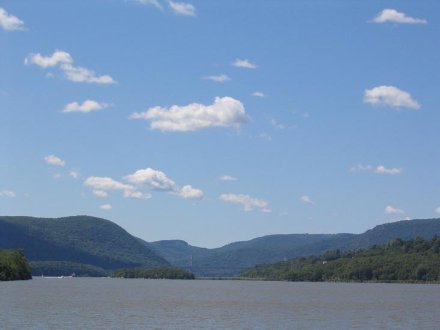
THE BRIDGE AND TUNNEL CLUB site often features photographs of myriad places, scenes, and things all around New York and beyond. Recently, the Bridge-and-Tunneller made a sojourn to various sites up the Hudson, and thankfully decided to share his photos. We bring you a selection of them, which you can find in their original form on the B&TC website. (more…)
Poor Old Bram
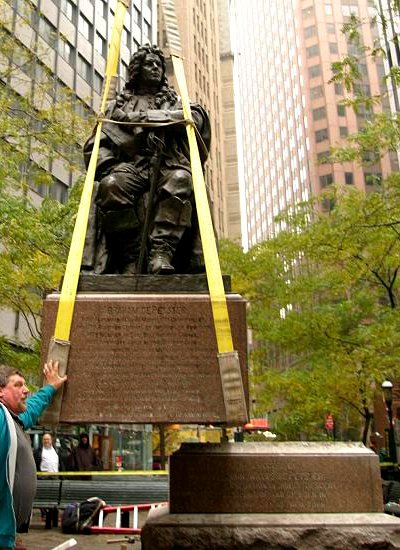
ONE HAS TO FEEL A certain amount of sympathy poor old Abraham de Peyster. The city fathers, in their infinite and unending wisdom, sought fit to erect a statue of Bram in Bowling Green, the old town square of New York down at the beginning of Broadway, many moons ago. However, having set Bram very nicely upon that green, the first public park in all New York, the city fathers have of late refused to let old Heer de Peyster rest. In 1972, the park was ‘renovated’ which entailed the statue’s forced removal. He ended up four years later in Hanover Square, a quite suitable though less prominent location, where he gazed across the square towards India House. It was then that old rivalries flared anew. (more…)
The Duke of York in New York
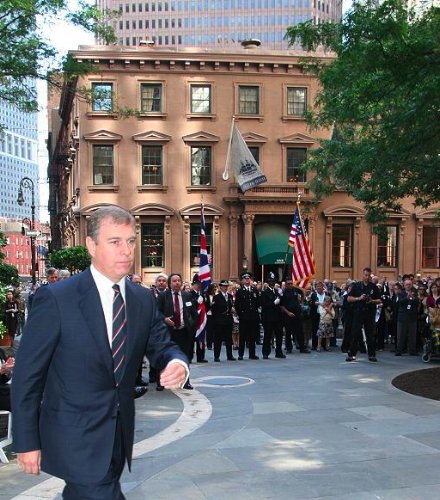
We neglected to mention Prince Andrew’s recent visit to New York in commemoration of the anniversary of the attacks on the World Trade Center. Sixty-seven British subjects died in the September 11, 2001 attacks, and eleven more were non-citizens with British ties. A ceremony was held in Hanover Square, where the British Memorial Garden is being built, followed by a reception at India House, which is located at No. 1 Hanover Square (the brown edifice in the photos above and below). (more…)
James II, Our Catholic King
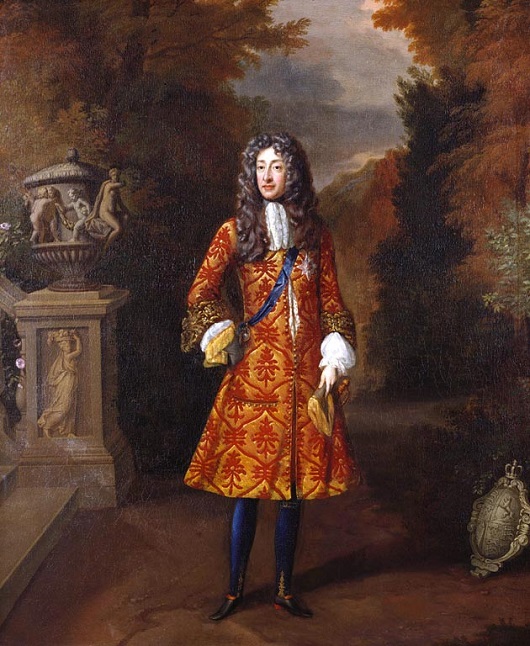
THIS PAST SATURDAY was the anniversary of the birth of King James II and VII of England and Scotland. The third son of Charles I, he was baptised into the Anglican church six weeks after his birth and was created Duke of York at eleven years of age. James married Anne Hyde, the daughter of the Earl of Clarendon, by whom he fathered eight children, though only two survived past childhood.
In 1664 the Duke of York equipped an expedition to relieve the Dutch of responsibility for their colonies in North America, and henceforth New Amsterdam and New Netherland were known as New York after their new Lord Proprietor.

Sometime during the year 1670 both the Duke and Duchess of York were received into the Catholic Church and stopped attending Anglican services, though the conversion did not become public knowledge until the Test Act (requiring officeholders to receive communion in a Church of England service and take an oath against Transubstantiation) was passed three years later. James was forced to renounce his offices, such as Lord High Admiral of England, though not his titles. At any rate, Anne, the Duchess of York had died in 1671 only a year after her conversion. He married Princess Maria of Modena in 1673.
The Protestant oligarchs felt threatened by the prospect of a Catholic king and thrice tried to pass laws barring James from succeeding to the throne. However his elder brother Charles II, the reigning king, dissolved parliament each time before the bill was to be passed. King Charles II died in February 1685, (having reconciled himself to the Catholic faith before his end) and thus the Duke of York was proclaimed James II of England and VII of Scotland. A private Catholic coronation was held at Whitehall Palace on April 22 before the public coronation the following day on the feast of Saint George, which was performed according to the rites of the Church of England.
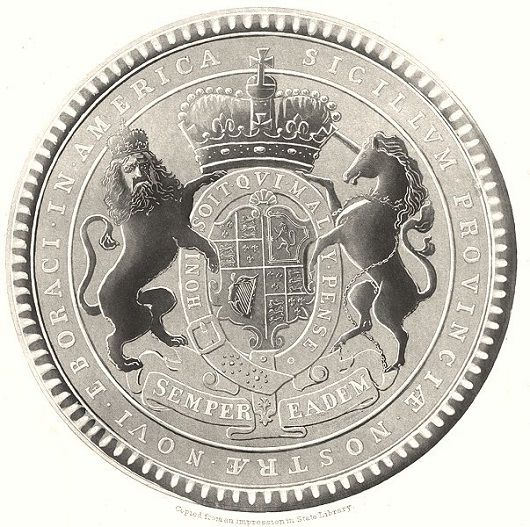
James had appointed the Catholic Thomas Dongan
as Governor of New York in 1682.
The Protestant oligarchs’ fears that James would end their hegemonic grip on Scotland and England proved well-founded as in 1687 he issued a Declaration of Toleration as King of Scotland, allowing Catholics, Episcopalians, and other non-Presbyterians to hold public office and the right of public worship, and a Declaration of Indulgence as King of England removing the laws penalizing non-attendance or non-communion at Church of England services, permitting non-Anglican worship in private homes or chapels, and abolishing religious oaths for public offices. Furthermore, James had allowed Catholics to hold positions at the University of Oxford for the first time since the Protestant Revolution. More provocatively, he tried to transform Magdalen College Oxford into a Catholic seminary. He had already reckoned with the rebellion of the Duke of Monmouth who proclaimed himself king two years earlier but had been captured, tried, and executed for treason. With the birth of a Catholic son and heir, Prince James Francis Edward, in 1688 a cabal of seven Protestant nobles issued an invitation to William of Orange, the Protestant Stadtholder of the Netherlands. A few months later, William of Orange duly arrived and usurped the throne, having already married James’ daughter Mary from his first marriage. The two ruled jointly as William and Mary.
Unwilling to create a popular martyr as had happened with the executed Charles I, William allowed James to escape and fled to France where Louis XIV gave the exiled monarch the use of a palace and an ample pension. James was intent on returning to his birthright, however, and took advantage of the Irish parliament’s refusal to recognise William’s usurpation of the throne. The King landed in Ireland in March of 1689 at the head of a Franco-Irish army but was defeated by William in the famous Battle of the Boyne in July 1690, and returned to his place of exile in France.
There, Louis allowed him to live in the château of Saint-Germain-en-Laye and offered to get James elected King of Poland but James felt this would prevent any chance of a Stuart again holding the throne of England. From that time onwards, James led a simple life of penance in reparation for his sins (he had had a number of mistresses in his younger days) and finally died in 1701. He was entombed in the Chapel of St. Edmund within the English Benedictine church on the Rue St. Jacques in Paris, while his brain was sent to the Scots College in Rome, his heart to the Visitandine Convent at Chaillot, and his bowels divided between the College of St. Omer (the exiled English Catholic school, now Stonyhurst in Lancashire), and the nearby parish church of St. Germain where they remained until they were desecrated by a Revolutionary mob and lost forever. His monument at Saint-Germain, however, was rediscovered in 1824 and is proudly displayed there to this day. There is also a monument to James and the Stuarts in St. Peter’s Basilica in Rome (c.f. Roma – Caput Mundi).
Aside from the pious tradition that Edward VII was received into the Church on his deathbed, James II was the last Catholic king (and as good King Edward never reigned over New York, James is even more certifiably so for us). There is a lovely coronation ode to James which I just might bring to your attention someday. But for now, reflect and remember our monarchs of old and pray that God in His mercy might grant us good Catholic rulers in stead of the shabby lot we elect today.
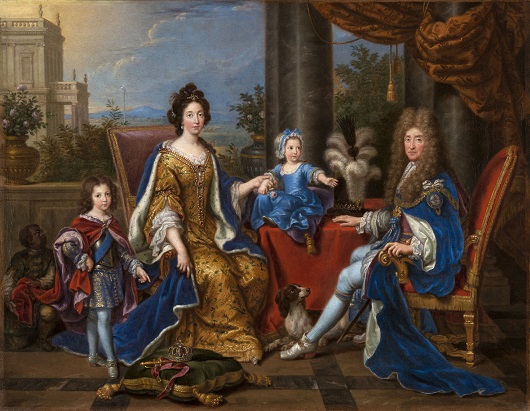
Old Dutch Gable
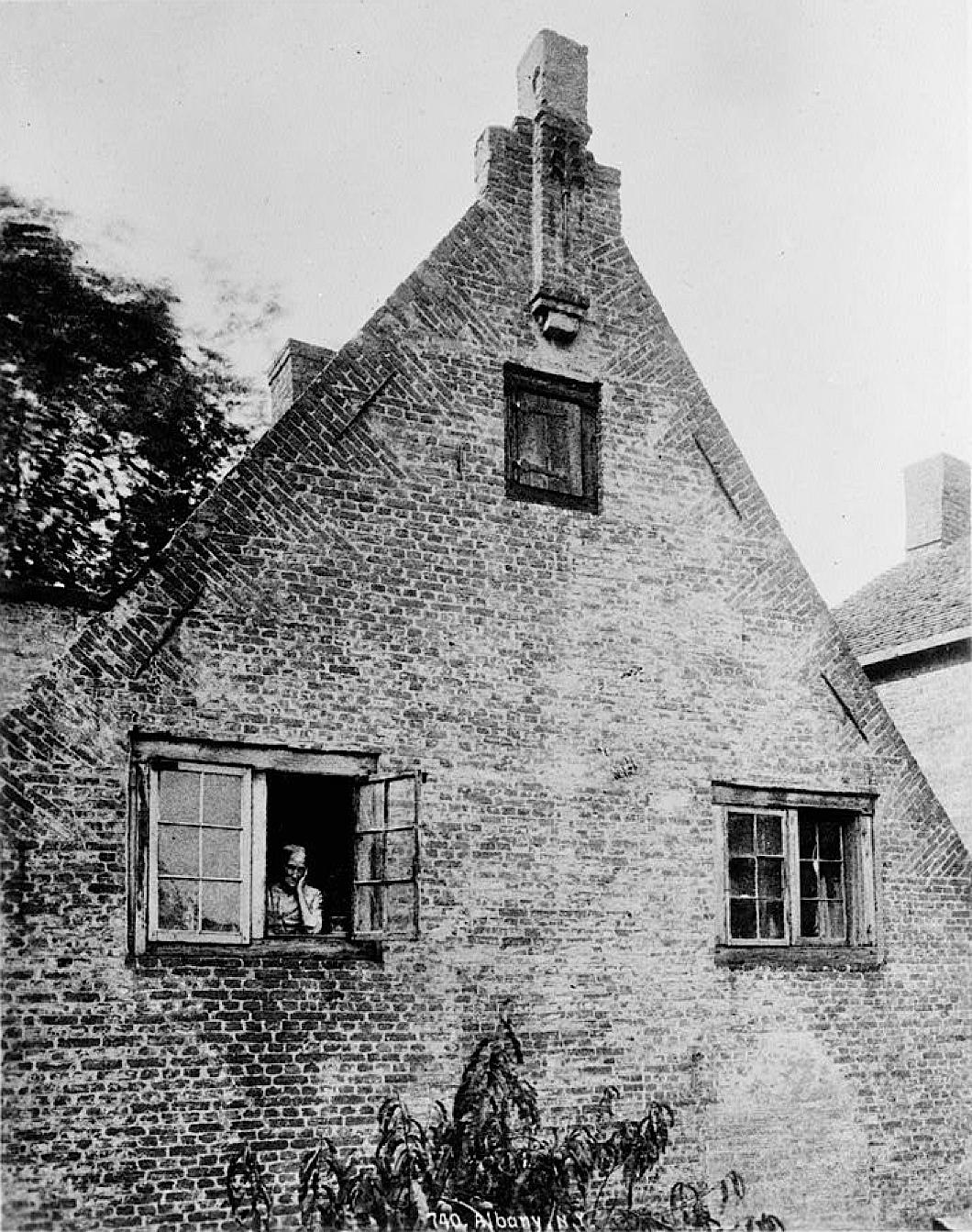
An old Dutch gable complete with old Dutch vrouw gazing miserably from the window. Albany County, New York, 1930’s.
The form of brick course on the gable is known as ‘mouse-tooth’ and is found primarily in Holland, East Anglia, and the Hudson Valley of New York, though also here and there in the American South.
A Book to Remember
Chumley’s Launch Party for ‘Forgotten New York’ Book
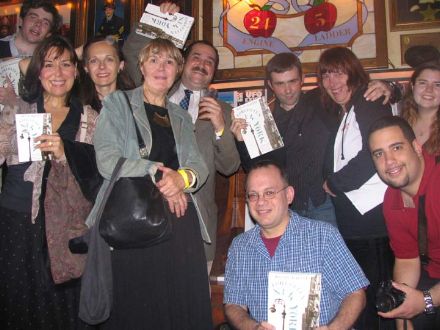
AS I GROW more and more cantankerous, my tolerance for evening trips down to Mannahatta declines, but on occasion there’s an event which would be a crime to miss. Last Thursday, Dawn Eden and I popped down to Chumley’s, the old speakeasy on Bedford Street in the West Village, for the shindig launching Kevin Walsh’s brilliant book, Forgotten New York: Views of a Lost Metropolis. (Kevin reports on the party here). I’ve been following Kevin’s Forgotten New York website for years now, and it has earned an unquestionable rank as one of my favorite sites ever (though, shamefully, I’ve never been on one of his legendary ‘Forgottentours’). The author himself was on hand, naturally, and I also enjoyed meeting a number of very kind people who are as fond of Forgotten New York as I am.
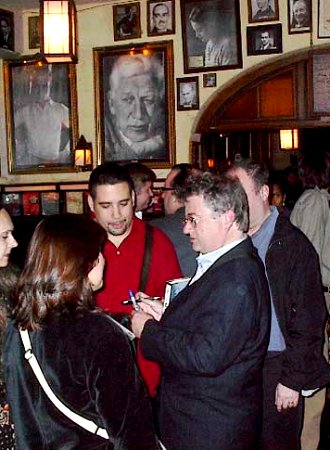
The Man of the Hour himself: Kevin Walsh (in glasses).
While Dawn and Kevin are familiar friends (she even gets a mention in the book’s acknowledgements), I had never before had the privilege of meeting this great chronicler of quinqueboronian miscellany. He is very much like his website: simple and brilliant. Happily, I got my complementary copy of the book personally inscribed, though I quite presumptuously upbraided him for only mentioning Audubon Terrace in passing (c.f. FNY: ‘I Can’t Drive 155’) while I believe it is worth a Forgotten page of its own. (Naturally, I have a post slowly developing on Audubon Terrace, which I believe is one of the most beautiful public spaces in all New York, as well as one of the most underappreciated).
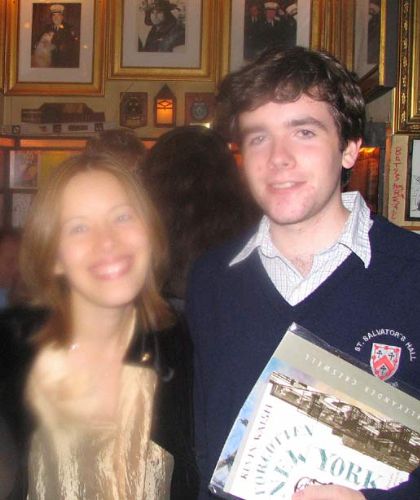
No, the camera isn’t smudged; an angelic haze follows Dawn wherever she goes.
But enough of the fun, how’s the book? Well I love it. It’s emphasis is on breadth rather than depth, since it’d be impossible to reproduce the entire contents of the encyclopedic website in a mid-sized paperback book. I view the book in two regards: first, as a handy basic guide referencing the variety of forgotten, unnoticed, and underappreciated sites around the Five Boroughs; and second, as a good jump-start companion to the more thoroughly informative website.
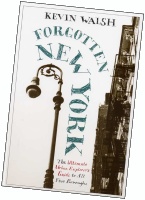
Take, for example, the Lent Riker Smith House out in Queens. Browsing through the book we see the entry on the ‘Lent Riker Smith Homestead’ which gives us two paragraphs of information. Enough to whet the appitite and plant the seed of intrigue, but when we check out the website’s entry on the house we get much, much more… and in color, to boot. I hope readers not yet familiar with the website will use the book as a springboard, but I also hope that we will be gifted with updated editions of the book in years to come, with added features.
Buy the book. Aficionados of forgotten-ny.com will appreciate a version of the familiar in dead-tree form, while the uninitiated will find it extremely useful as a foundation for appreciating Gotham’s numerous nooks and crannies. Kevin Walsh has done a great service to all those who have a love for the Big Apple.
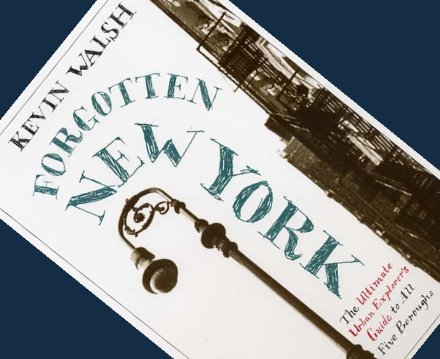
The Old Police Headquarters
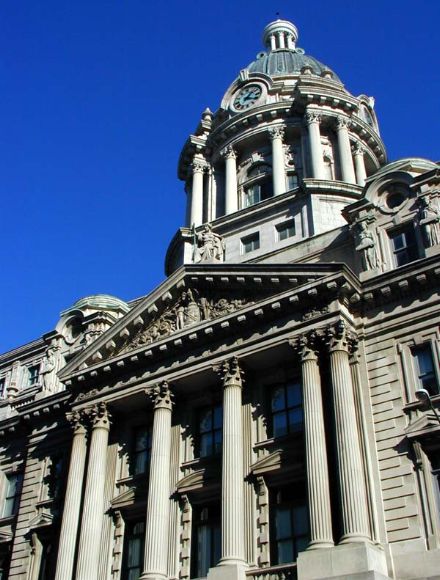
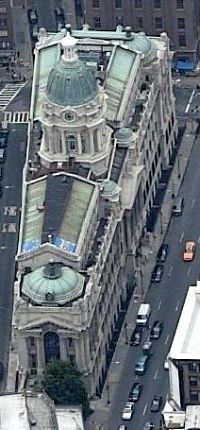 ONE OF THE finest buildings in all New York is also one of the least-appreciated and most forgotten. The old Police Headquarters at No. 240 Centre Street was built in 1909 on a triangular lot in what was then solidly Little Italy. Arguably, it is today located in the ever-expanding Chinatown, but real estate brokers usually describe its location non-ethnically as Soho, just on the cusp of the area which is increasingly (and most irritatingly) known as NoLIta, ‘North of Little Italy’.
ONE OF THE finest buildings in all New York is also one of the least-appreciated and most forgotten. The old Police Headquarters at No. 240 Centre Street was built in 1909 on a triangular lot in what was then solidly Little Italy. Arguably, it is today located in the ever-expanding Chinatown, but real estate brokers usually describe its location non-ethnically as Soho, just on the cusp of the area which is increasingly (and most irritatingly) known as NoLIta, ‘North of Little Italy’.
From the basement shooting range to the rooftop observation deck, the building was designed in the monumental Beaux-Arts style by the firm of Hoppin & Koen, “to impress both the officer and the prisoner with the majesty of the law.” The New York Times wrote that “its grandeur contrasted utterly with the little buildings and crooked streets around it.”
The older old Police Headquarters, where reformer Teddy Roosevelt held court as Police Commissioner, was located nearby on Mulberry Street and when the nerve center of the N.Y.P.D. shifted to Centre St. between Broome and Grand, the gun shops, cop saloons, and police reporters followed suit. One restaurant across the street was simply called ‘Headquarters’. With its oak bar and ceiling of carved wood, the ‘Headquarters’ restaurant became a particular favourite among the higher brass of the N.Y.P.D. According to popular lore, a tunnel was actually constructed connecting the restaurant with the actualy Police HQ, in which a number of the Boys in Blue used to enjoy a drink during the trying days of Prohibition. (more…)
Vienna on 43rd Street
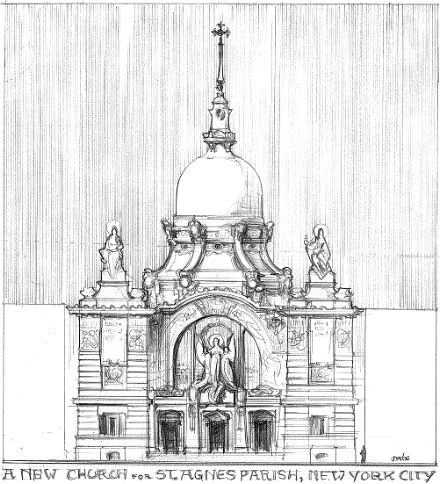
A WEEK AGO AFTER the 11 o’clock Sunday Mass at St. Agnes, Dino Marcantonio, Matt Alderman, and I stood in front of the church and fantasized about how we would fix the old place. Well, perhaps ‘old’ isn’t the right word for the place. While the parish was founded in the 1840’s, the current church building only dates from the late 1990’s, built after the old Victorian edifice was consumed by fire. As for design, its heart is in the right place, but as they say the Devil is in the details. The interior is marred by quite obviously large joints between component parts of arches and cornices and the exterior just looks fake. Is craftsmanship dead? No, but it helps to search it out instead of accepting just any old thing.
At any rate, Matt Alderman has thrown together these esquisses of what his St Agnes would look like, and it’s all rather Austrian. (more…)
The Jefferson Guards
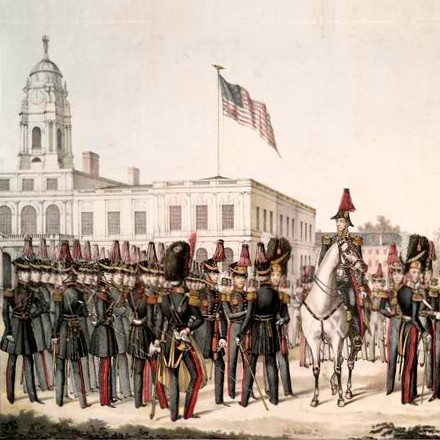
I recently stumbled upon this image depicting a militia regiment gathered in front of New York’s City Hall. The unit in question is the Jefferson Guards, 38th Regiment, New York State Artillery, amassed in bearskin caps and red-plumed shakos (red being the traditional color of the artillery). I confess I’d never heard of the Jefferson Guards before, but this is not entirely surprising. The Armed Forces of the State of New York – today composed of the New York Army National Guard, the New York Air National Guard, the New York Guard, and the New York Naval Militia – was once composed of a vast array of assorted regiments, battalions, and companies (a quite literal example of the ‘little platoons’ praised by Burke). These militia companies varied greatly in form, from little more than glorified social clubs to the crack units of the day.
As strange as it may seem, considered as a whole they were an almost completely organic military and, while they would be ill-suited to the armed exigencies of today, I refuse to believe that our little realm is better off for their general disappearance. Certainly the V.C.A. and the Old Guard, among others, survive to this day (in a somewhat different form, naturally), but what of the Empire Light Cavalry and the German Horse Guards? The Ulster Guard, the Weschester Chasseurs, and the New York Highlanders? The gallant Seventh Regiment of New York survived even into the 1990’s before its dissolution was ensured by the monotony monitors who now, fifteen years later, seek to destroy the great and blessed monument of an armory on Park Avenue which the Seventh built and guarded for over a century. We mourn their disappearance, just as we detest the continued and increasing disdain for the proud military heritage of the City and State of New York, but the entire culture which created and sustained them is gone, too.
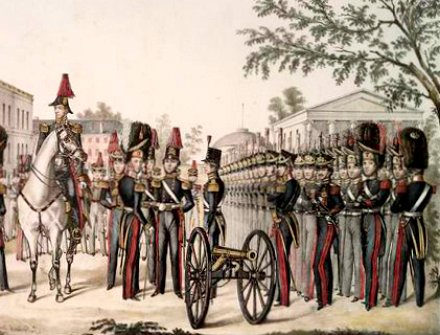
Category: Militaria – New York
The Neue Galerie

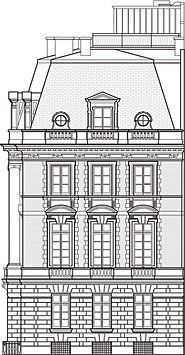 THE RECENT PURCHASE for the Neue Galerie of Gustav Klimt’s 1907 ‘Adele Bloch-Bauer I’ (above), alledgedly for a record-breaking price of $135,000,000, gives me the perfect opportunity to write a post on the eponymously recent addition to New York’s coterie of art museums. Since its 2001 opening, the Neue Galerie has resided in the handsome 1914 beaux-arts mansion on the corner of Fifth Avenue and 86th Street, designed by Carrère and Hastings (of New York Public Library fame) for industrialist William Starr Miller and later inhabited by Mrs. Cornelius Vanderbilt III. In the time since the construction of No. 1048, the rest of Fifth Avenue has undergone a lamentable transformation from a boulevard of beautiful townhouses and mansions to an avenue predominantly consisting of apartment buildings. While one appreciates the inoffensive design of the pre-war buildings on Fifth, there remain a number of thoroughly opprobrious modern interlopers which offend the graceful avenue. One can’t help but pine for Fifth Avenue before the mansions came down, but we can at least give thanks for holdouts like the Neue Galerie. (more…)
THE RECENT PURCHASE for the Neue Galerie of Gustav Klimt’s 1907 ‘Adele Bloch-Bauer I’ (above), alledgedly for a record-breaking price of $135,000,000, gives me the perfect opportunity to write a post on the eponymously recent addition to New York’s coterie of art museums. Since its 2001 opening, the Neue Galerie has resided in the handsome 1914 beaux-arts mansion on the corner of Fifth Avenue and 86th Street, designed by Carrère and Hastings (of New York Public Library fame) for industrialist William Starr Miller and later inhabited by Mrs. Cornelius Vanderbilt III. In the time since the construction of No. 1048, the rest of Fifth Avenue has undergone a lamentable transformation from a boulevard of beautiful townhouses and mansions to an avenue predominantly consisting of apartment buildings. While one appreciates the inoffensive design of the pre-war buildings on Fifth, there remain a number of thoroughly opprobrious modern interlopers which offend the graceful avenue. One can’t help but pine for Fifth Avenue before the mansions came down, but we can at least give thanks for holdouts like the Neue Galerie. (more…)
Racialist Thinking Behind the Times
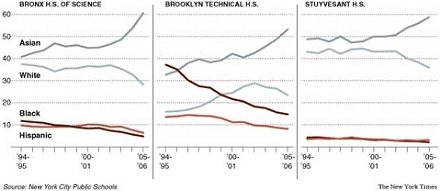
The fair-minded, independent observer would look at the figures above and think to himself “Interesting, the proportion of Asian students is on the rise, while that of White, Black, and Hispanic students is generally in decline”. However the racialists (I will not use the more loaded term of ‘racist’, though the meaning is exactly the same) at the New York Times can only see the Black and Hispanic decline, captioning the chart ‘The share of black and Hispanic students New York City’s three most elite specialized schools has declined’.
And why no chart depicting the racial make-up of the also public selective Hunter College High School? Is it, by some unknown criterion, not in the same league or perhaps the proportion of black and Hispanic students there actually rose? The Times reader is left uninformed as to the greater picture, but suitably inculcated in racialist thinking.
Gothamist’s Jen Chung notes the decline is “in spite of the city’s best efforts to encourage [Black and Hispanic students] to apply and attend” while City Councilman Robert Jackson ponders “”Is it institutional racism or is it something else?”.
Could it perhaps be that the racial makeup of the city’s elite public high schools is subject to (quel horreur!) occasional fluctuations? What is the racial makeup of an elite public high school “supposed” to be? Here’s a concept worth considering: how about giving the students in selective public high schools the best education on offer and admit students based purely on a meritocratic standard which does not descriminate by sex, race, class, or creed? Just a thought.
The Haunting Richardsonian
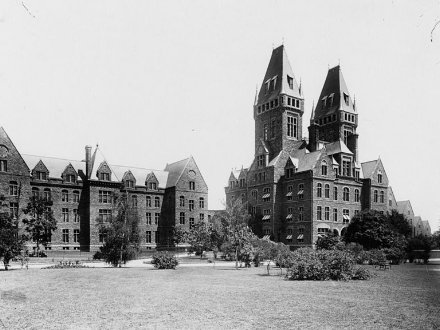
ONE OF THE splendid things about New York is that it’s a land which continually manages to throw up a surprise or two, even to time-hardened devotées of all things knickerbocker such as yours truly. One of my most recent discoveries is the fabulously haunting and impressive Buffalo State Hospital out in the far west of the Empire State.
The magnificent building was built to the design of Henry Hobson Richardson, the progenitor of the eponymous ‘Richardsonian Romanesque’ style, as one of a series of governmental asylums for the insane founded throughout the nineteenth century. Richardson also did a great deal of work on the Capitol in Albany, designing the south façade which, since the construction of Nelson Rockefeller’s Little Brasilia, is now the main façade of the building and was inspired by the Hôtel de Ville in Paris.
Construction on the State Hospital began in 1870, and the central administration block with its two towers and a number of flanking pavilions housing patients were opened in 1880. Interestingly, the towers which so dominate the building are purely decorative and remain unfinished on the interior.
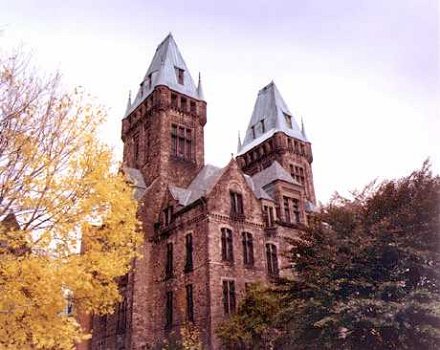
The footprint of the building follows the V-shaped Kirkbride plan, conceived by Pennsylvania’s Dr. Thomas Story Kirkbride in his 1854 opus, On the Construction, Organization and General Arrangements of Hospitals for the Insane which revolutionized care for the mentally unstable in the nineteenth century. The location was a 100-acre parcel of property near the city of Buffalo, and the grounds were landscaped by Frederick Law Olmsted, who designed Central Park with Calvert Vaux.
The grounds originally included farms which helped to feed the patients and staff, but in the 1920’s this land was redeveloped as the Buffalo State College, now the University at Buffalo (State University of New York). The hospital, renamed Buffalo Psychiatric Center, moved out of the Richardsonian complex into a plain, ugly, modern building on the grounds in the 1960’s, leaving the beautiful Victorian structure to rot and ruin.
However recent efforts by Buffalo and New York state officials have led to the replacement of the roof and other work to ensure the continued integrity of the building. The latest plans would have the building serve an educational function under the auspices of the State University next door, an appropriate purpose for this majestic gem of New York architecture.
Search
Instagram: @andcusack
Click here for my Instagram photos.Most Recent Posts
- Amsterdam November 26, 2024
- Silver Jubilee November 21, 2024
- Articles of Note: 11 November 2024 November 11, 2024
- Why do you read? November 5, 2024
- India November 4, 2024
Most Recent Comments
- on The Catholic Apostolic Church, Edinburgh
- on Articles of Note: 11 November 2024
- on Articles of Note: 11 November 2024
- on Why do you read?
- on Why do you read?
- on University Nicknames in South Africa
- on The Situation at St Andrews
- on An Aldermanian Skyscraper
- on Equality
- on Rough Notes of Kinderhook
Book Wishlist
Monthly Archives
Categories

